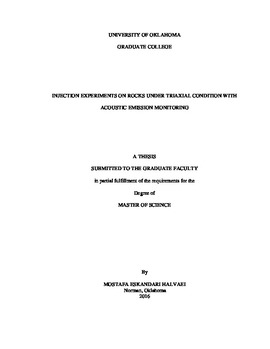| dc.contributor.advisor | Ghassemi, Ahmad | |
| dc.contributor.author | Eskandari Halvaei, Mostafa | |
| dc.date.accessioned | 2016-08-29T12:49:35Z | |
| dc.date.available | 2016-08-29T12:49:35Z | |
| dc.date.issued | 2016-12 | |
| dc.identifier.uri | https://hdl.handle.net/11244/45032 | |
| dc.description.abstract | This work presents the results of a series of triaxial- injection experiments carried out on two basalt cores from the Newberry geothermal field well GEO-N2 and a Mississippi lime stone. A combination of triaxial and injection experiments were performed on the cores to characterize their goemechanical properties and to better understand their response to stimulation treatment. The first GEO-N2 sample (sample A) was axially loaded to a vertical stress of 10000 psi at a strain rate of 1x10-5 strains/sec while maintaining an effective confining pressure of 3500 psi and a temperature of 90 oC. Nitrogen gas was injected at a pressure of 2000 psi. Sample didn’t fail. Then the pore pressure increased to 4500 psi resulting in an effective confining pressure of 1000 psi. However the sample still did not fail due to injection. Since the intention of the test was to create the Mohr - Coulomb envelope by performing a multistage triaxial test, the deviatoric stress did not get increased to fracture the sample and sample fractured by multistage triaxial test.
The triaxial-injection test performed on the second GEO-N2 sample (sample B) same as the first GEO-N2 sample with the same procedure and configurations. For the last part of the test, the intention was to fail the rock with injection. Therefore, at the moment of the turning point on the volumetric strain curve, the axial load was held constant and the sample was fractured by injecting nitrogen gas in to it. The sample temperature was 90o C.
The Mississippi lime stone sample (sample C) was axially loaded to a vertical stress of 6000 psi at a strain rate of 1x10-5 strains/sec while maintaining an effective confining pressure of 2000 psi. Nitrogen gas was injected at a pressure of 2000 psi. Sample didn’t
xiv
fail. Then the pore pressure increased to 3300 psi resulting in an effective confining pressure of 700 psi. However the sample still did not fail due to injection. For the last part of the test, the intention was to fail the rock with injection. Therefore, at the moment of the turning point on the volumetric strain curve, the axial load was held constant and the sample was tried to be fractured by injecting nitrogen gas in to it. However it did not fractured and sample C got fractured by compression.
Fluid flow was maintained across the samples throughout the experiments while stress, strain and acoustic emissions were recorded. Rock deformation and acoustic emissions data were monitored and analyzed, and the locations of events were recorded and they correlate with the fracture location in the samples. The result showed that all three samples have high value of Young’s modulus over a 40 GPA. Sample A and B experiments were conducted at elevated temperatures to investigate the rock response to thermal stresses. Heat didn’t influence the elastic properties very much in these rocks. It is estimated that higher temperatures (>300 C) would probably create this effect. And about 0.03% strain was observed in hydrostatic heating of the sample. Sample C is from an oil field which is not hot and the tests on this sample were not performed at high temperature. | en_US |
| dc.language | en_US | en_US |
| dc.subject | Triaxial Injection Test | en_US |
| dc.subject | ACOUSTIC EMISSION | en_US |
| dc.subject | Rock Test | en_US |
| dc.title | INJECTION EXPERIMENTS ON ROCKS UNDER TRIAXIAL CONDITION WITH ACOUSTIC EMISSION MONITORING | en_US |
| dc.contributor.committeeMember | Jamili, Ahmad | |
| dc.contributor.committeeMember | Fahes, Mashhad | |
| dc.date.manuscript | 2016-08-26 | |
| dc.thesis.degree | Master of Science | en_US |
| ou.group | Mewbourne College of Earth and Energy::Mewbourne School of Petroleum and Geological Engineering | en_US |
